MARIANI’SVirtual
Gourmet
March 3,
2013
NEWSLETTER
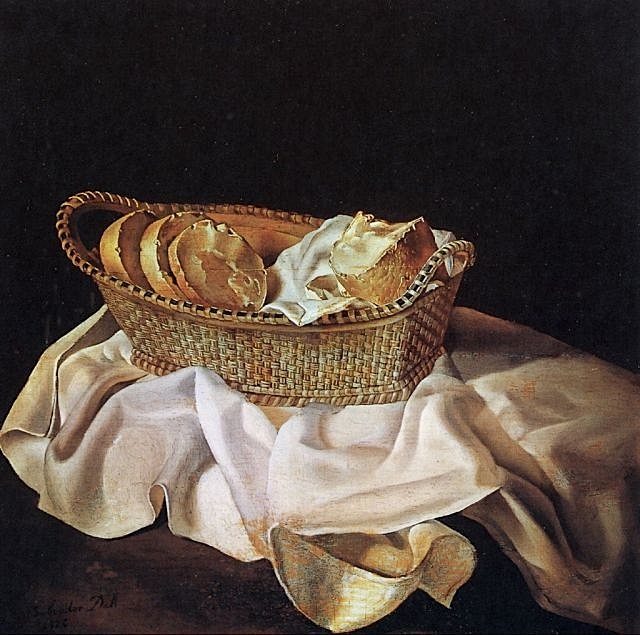
ANNOUNCEMENT:
There will be no edition of Mariani's
Virtual Gourmet on March 11,
because Mariani will be in Tucson, Arizona,
eating tamales, enchiladas, burritos,
tostones, tacos, tortillas, and churros, all
on one plate.
THIS
WEEK
BEEFING UP IN MENDOZA
by John
Mariani
NEW YORK CORNER
S Prime
by John Mariani
NOTES
FROM THE WINE CELLAR
UNDERSTANDING WINESPEAK
by John Mariani
❖❖❖
by John Mariani
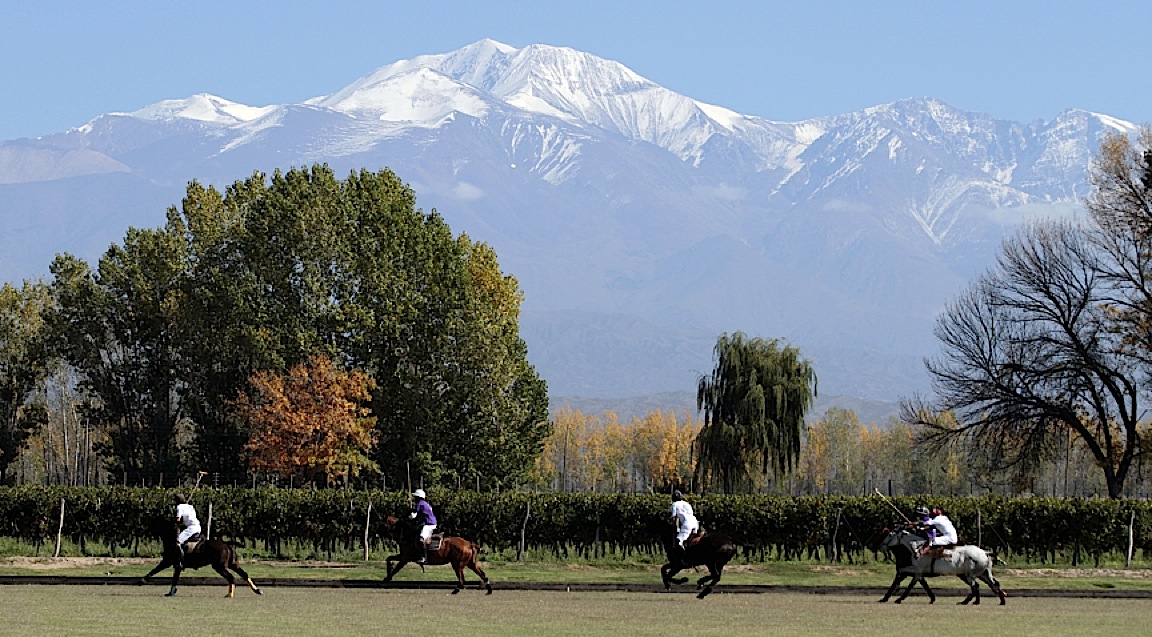
Argentina,
I was not entirely surprised to learn, is
the fifth largest country in the world,
and looking  at it on
the map, stretching way down to Patagonia and
the very tip of South America, there's no reason
to doubt it. If they could only get those pesky
Falkland Islands back from the Brits, it would
be even bigger. I've seen very little of
it, but now I've seen Mendoza, whose existence
these days owes much of its prosperity to the
wine trade and vineyards that surround it.
I will be reporting on the wines I drank with
such pleasure there in a few weeks, but for now
let me concentrate on the city and its
gastronomy, which is, as it is everywhere in
Argentina, based on beef, beef, and more
beef. Americans may say "A day without
orange juice is like a day without sunshine" but
the Argentinians say, "A day without beef is
unthinkable!"
at it on
the map, stretching way down to Patagonia and
the very tip of South America, there's no reason
to doubt it. If they could only get those pesky
Falkland Islands back from the Brits, it would
be even bigger. I've seen very little of
it, but now I've seen Mendoza, whose existence
these days owes much of its prosperity to the
wine trade and vineyards that surround it.
I will be reporting on the wines I drank with
such pleasure there in a few weeks, but for now
let me concentrate on the city and its
gastronomy, which is, as it is everywhere in
Argentina, based on beef, beef, and more
beef. Americans may say "A day without
orange juice is like a day without sunshine" but
the Argentinians say, "A day without beef is
unthinkable!"
One thing must be said about Argentine
beef, which, like European beef, is all
grass fed and not aged. Nothing wrong with
that unless you have eaten in the best U.S.
steakhouses that obtain corn-fed beef that is
dry aged (increasingly rare to find). So,
the Argentine variety is never going to have
that deep, fat-riddled quality that the best in
the U.S. has. But Argentina's best is very
very good indeed, chewy but good. But first, a
little about the city.
The city was settled in 1461
by Spain's Pedro del Castillo, and,
despite the devastating earthquake of
1861, was rebuilt better and stronger, so that
today it is a city of broad avenues, all of them
edged with irrigation ditches--the city's mantra
is "Mind the Ditches!"--that make it inhabitable
for its population of 112,000, owing to its
location in the high desert. Today, with
wine and olive oil its principal industries, it
brings in tourists who enjoy visiting the
wineries, one of which, Bodegas Escorihuela, is
located right in town, with a fine restaurant
named 1884 (see below).
Many beautiful parks
throughout Mendoza also make the city very
appealing for both visitors and locals, and you
can rent a bicycle at Bikes and Wine, then tour
the parks for the whole day. The largest
and most splendid is Parque General San Martin (above),
named after the hero of Argentine independence
(you'll find his name on everything in the city,
from streets to buildings); it is 1,200
acres--larger than NYC's Central Park--designed
by Carlos Thays and opened in 1896.
It is also a city of eight
plazas that open up the center and allow for
casual strolls and ice cream on a hot day. The
most popular is the Plaza Independencia, and
Plaza Italia (left)
is dedicated to Italian immigrants who came to
Argentina in huge numbers in the 19th and early
20th centuries. There's even a statue of Rome's
founders, Romulus and Remus.
Compared
with Buenos Aires, which I shall report on soon,
Mendoza is not a great shopping city, though it
is very pleasant to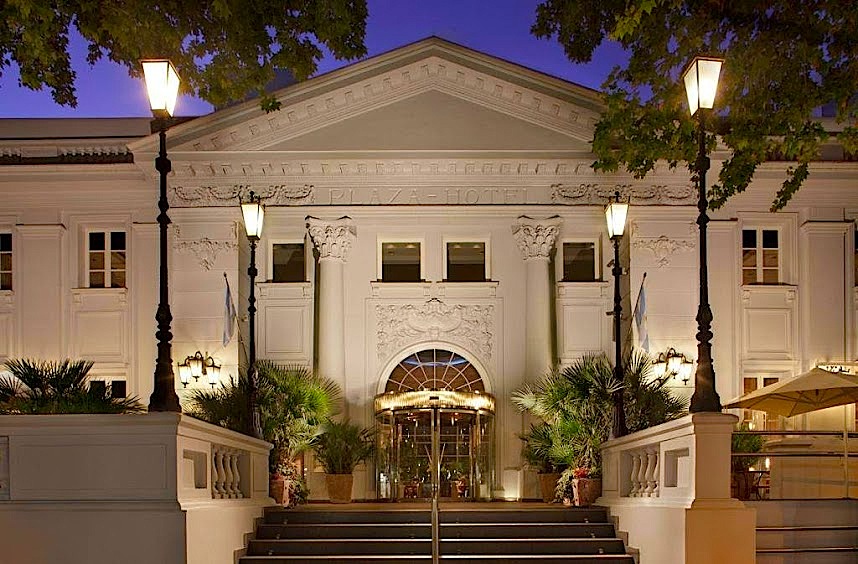 walk down the broad Boulevard Sarmiento, free
from cars and lined with boutiques and restaurantes
and cafés of every stripe. Be aware,
however, that the Mendozans keep to the
tradition of the siesta, closing shops at 1 PM,
having lunch at home then taking a rest,
re-opening at 5 PM, which leads them to a
very late dinner hour.
walk down the broad Boulevard Sarmiento, free
from cars and lined with boutiques and restaurantes
and cafés of every stripe. Be aware,
however, that the Mendozans keep to the
tradition of the siesta, closing shops at 1 PM,
having lunch at home then taking a rest,
re-opening at 5 PM, which leads them to a
very late dinner hour.
At the end of the street,
just across the park, is the Park
Hyatt Mendoza (right), considered the city's
best hotel, which has every modern amenity, not
least wi-fi access (not always easy to find in
Mendoza) and a highly helpful business
center. There is also a small casino on
premises. Bistro M here
offers an extensive buffet breakfast in the
morning, and I 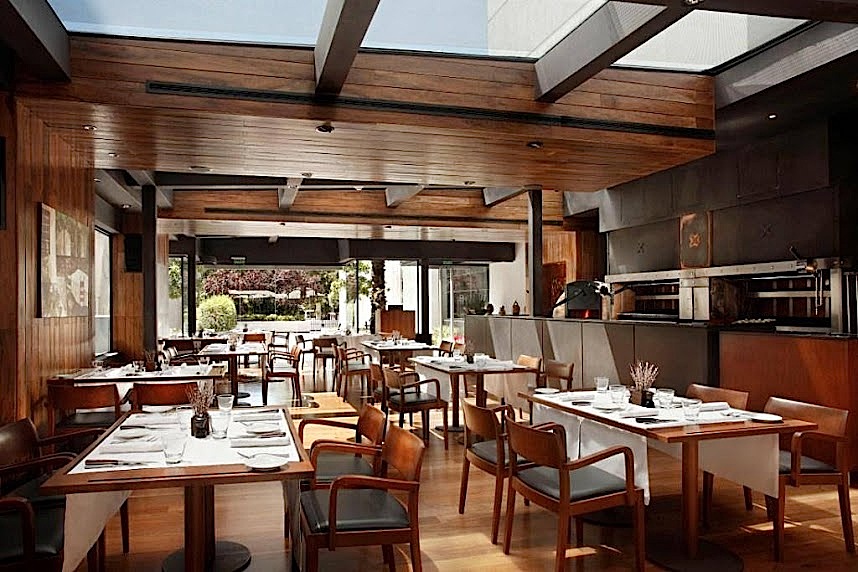 had a
fine plate of gnocchi for lunch. Grill Q (below) is a
beautiful, sunny spot to introduce you to the
Argentine parilla,
which features--as you might guess-an array of
cuts of beef and other meats, done in front of
you on the grill and sliced to your request,
accompanied by a wide array of vegetables, and
an outstanding wine list of 4500 regional
labels.
had a
fine plate of gnocchi for lunch. Grill Q (below) is a
beautiful, sunny spot to introduce you to the
Argentine parilla,
which features--as you might guess-an array of
cuts of beef and other meats, done in front of
you on the grill and sliced to your request,
accompanied by a wide array of vegetables, and
an outstanding wine list of 4500 regional
labels.
Within blocks of the hotel
are two well-regarded restaurants, one named Francesco
Barbera that is set up for delightful al
fresco dining. The chef here is
86-year-old woman named Maria Teresa, as spry as
ever she's been in the 60 years she has been
cooking. I found the menu quite traditional
Italian, except for the Argentine empanadas,
and of course there is beef in several versions.
We went at 8 PM and the place was dead; when we
left at 11, it was packed.
In the
other direction from Francesco Barbera lies the
best restaurante in a far more modern style,
called Azafrán,
opened in 2001 in a space that used to be a
delicatessen. Here Chef-manager Pablo
Ranea (below,
far left) is doing what he calls "New
Argentinean Cuisine," which means taking the
traditions of the country's gastronomy and
playfully updating it and presenting it in
stunning new ways. The restaurant also has
within its space a wine room where you can pick
out and purchase bottlings from a stellar
array. I allowed Ranea to choose my meal and was
impressed by what came from the kitchen,
beginning with crispy olives stuffed with goat's
cheese that popped in the mouth. Warm Camembert
was served with fresh peach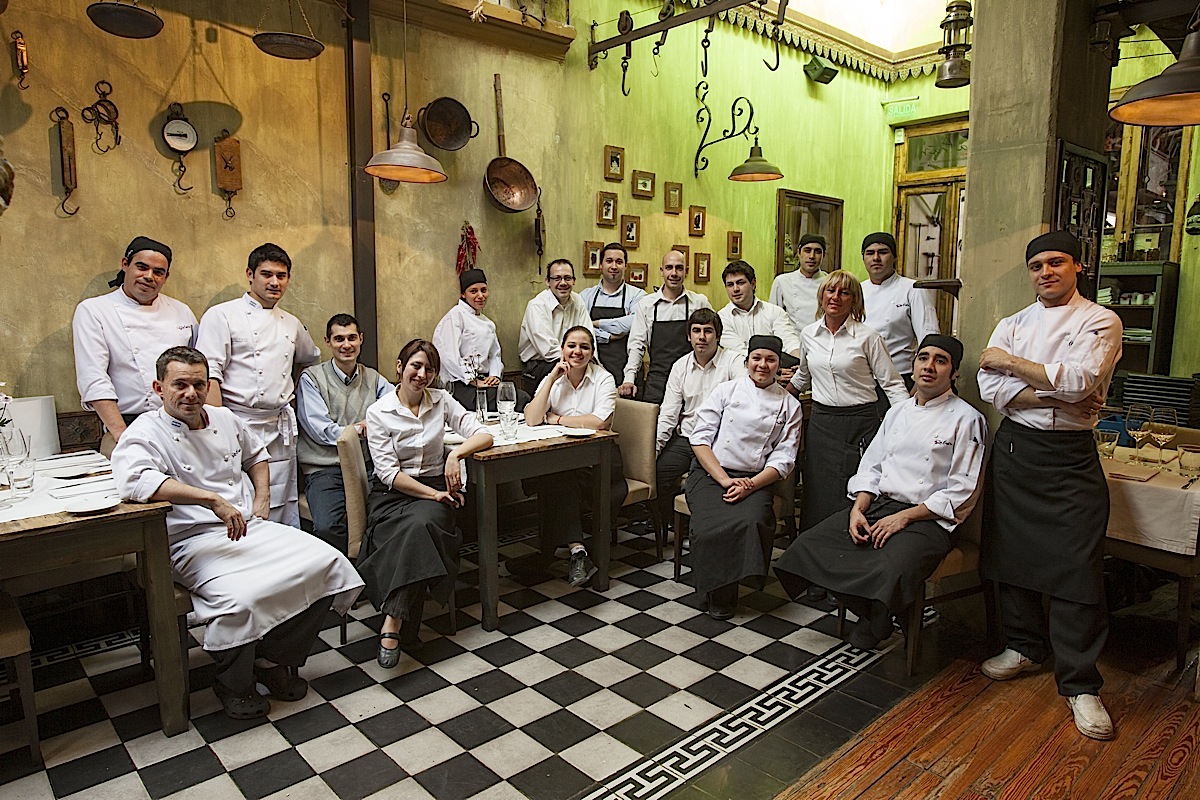 and shallot-studded vinaigrette,
then came a trio of empanadas (below)--
and shallot-studded vinaigrette,
then came a trio of empanadas (below)--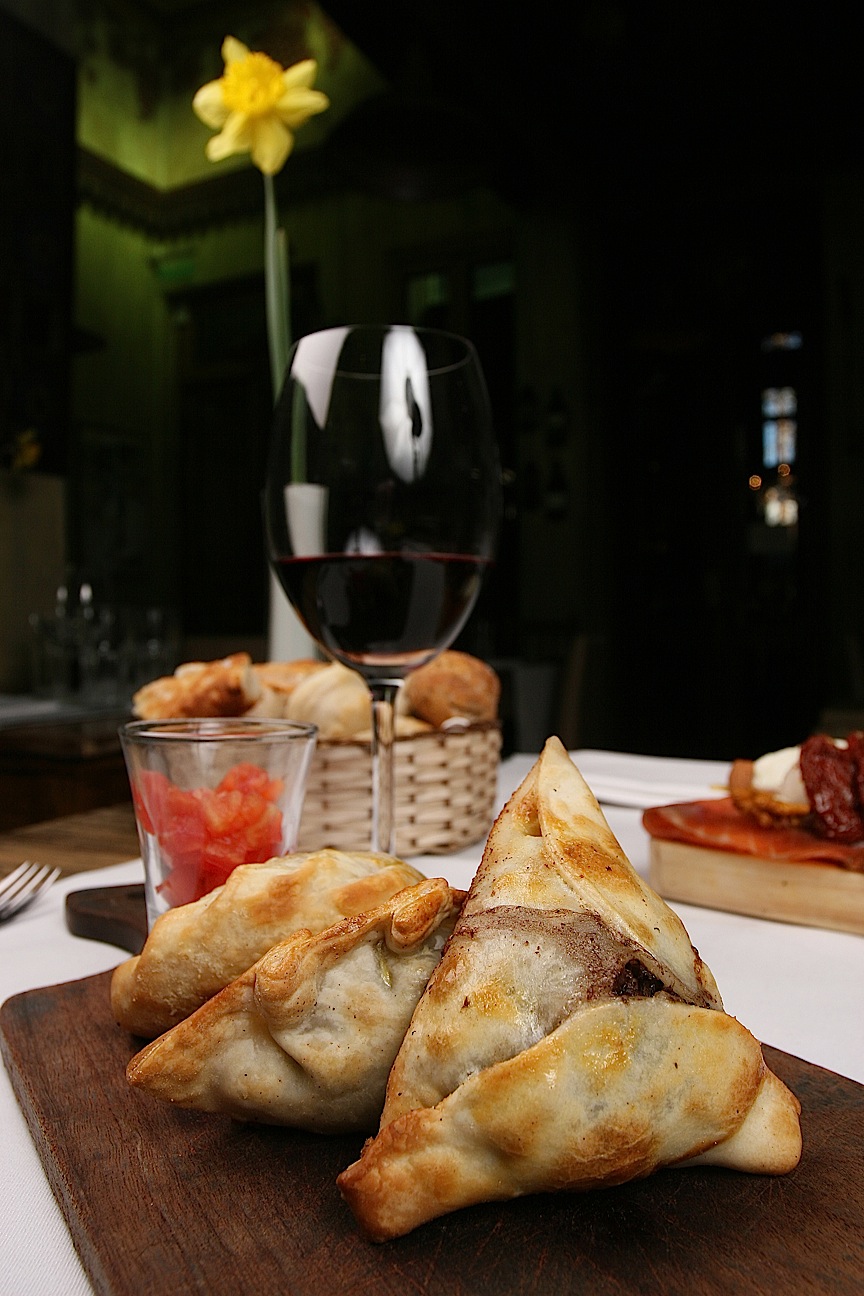 spread
Argentinians are addicted to) crème
brûlée with rice pudding and
biscotti. Well-chosen wines were poured throughout
the meal, which is one of the best I've had in
South America. If you had time for only one
meal in Mendoza, Azafrán is the place to
go.
spread
Argentinians are addicted to) crème
brûlée with rice pudding and
biscotti. Well-chosen wines were poured throughout
the meal, which is one of the best I've had in
South America. If you had time for only one
meal in Mendoza, Azafrán is the place to
go.
We had another outdoor meal
at 1884
Restaurante (below), the one within the
winery, in the Godoy Cruz neighborhood. Here
master chef Francis Mallmann prepares his famous
seven-hour grilled lamb, cooked in a mold.
The restaurant, built in the Spanish
style, was opened in 1996 by Dr. Nicolas
Catena Zapata, head of one of the country's most
extensive wine holdings, and it draws from the
best agricultural products it is possible to
produce or buy. The menu, changes every two
weeks.
1996 by Dr. Nicolas
Catena Zapata, head of one of the country's most
extensive wine holdings, and it draws from the
best agricultural products it is possible to
produce or buy. The menu, changes every two
weeks.
On a
winery visit well outside of the city, I stopped
for lunch at a very popular pulperia, a
term for an old-fashioned bar where caballeros
would stop to refresh their horses and
themselves. Today La Juntada is a darling,
rustic restaurant where the meats are cooked
outside (below)--beef,
lamb, goat--and brought sizzling to the rough-hewn
tables, along with salads and empanadas. One
particularly savory 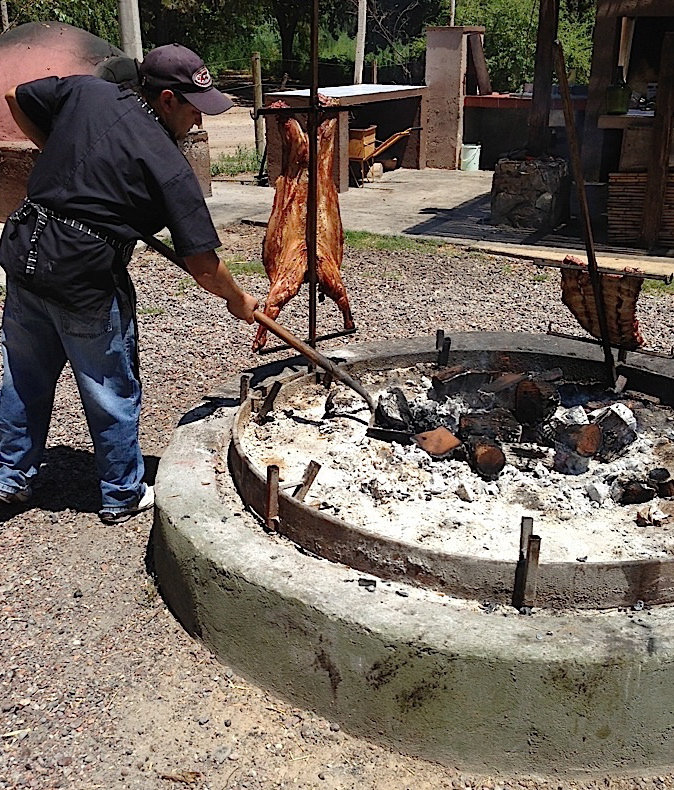 empanada
contained scallion, onion and bacon, and there was
a tasting of regional products like cheese,
salami, olives and marinades of turkey and
hen.
empanada
contained scallion, onion and bacon, and there was
a tasting of regional products like cheese,
salami, olives and marinades of turkey and
hen.
The goat ribs were succulent to
the bone, and then came the even more delicious
piglet with mahogany-colored crisp skin and silky,
fatted meat underneath. Desserts included
pears--then in season and bursting with
flavor--soaked in Malbec wine. 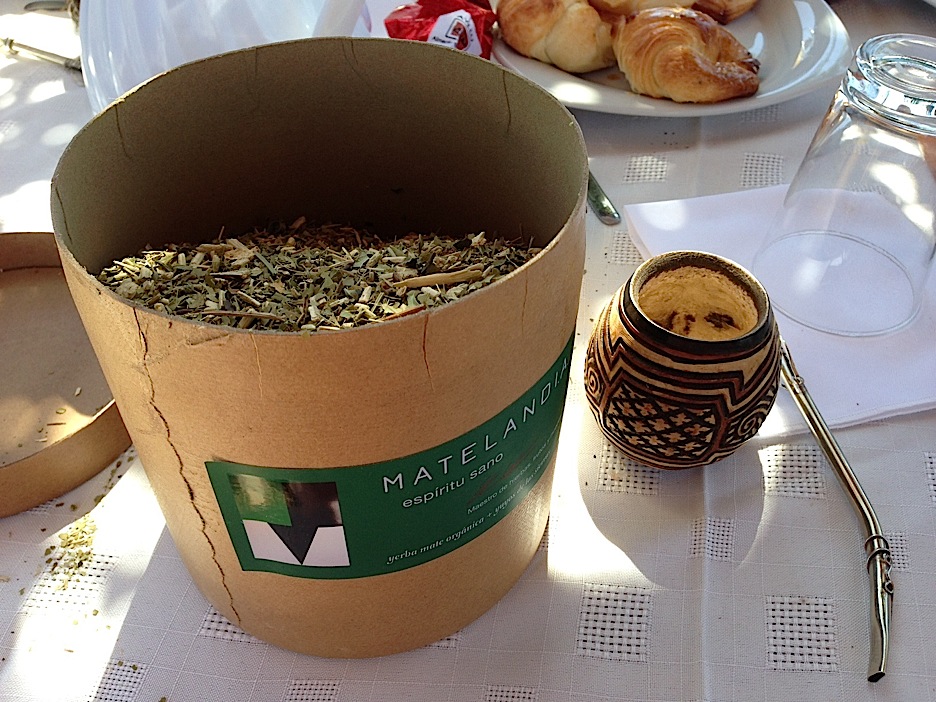
Prior to visiting La Juntada, we
had been in a high altitude vineyard owned by the
Alamos winery, which was kind enough to bring us
delectable little fried tortas made right there in the
vineyard, along with a national obsession, a
tea-like drink called mate (right) which has a ritual about
it as rigorous as high tea in London. You
place a couple of teaspoons and sugar into a
little wooden cup, pour boiling water down the
side, let it steep then drink it through an
ornate, decorated silver straw. To me it was
a fairly bitter taste not acquired on the spot,
but no one should visit Mendoza without taking a
crack at mate.
by John Mariani
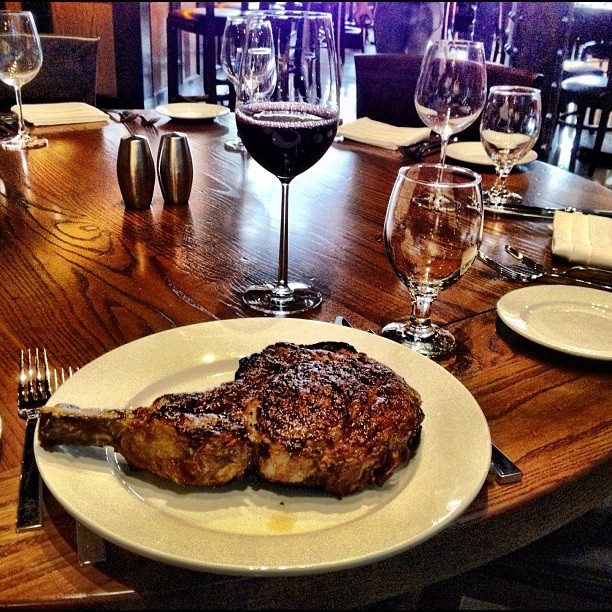

35-15 36th Street
Long Island City, NY
718-707-0660
www.sprimenyc.com
And while we're on the subject of beef, none
I ate in Argentina can compare with that served at the
six-month-old S Prime in Queens, which I've been
predicting will be the next borough the food media
suddenly finds has wonderful restaurants. Of
course, it always has, from the Flushing Mall, with its
much-praised Hai Di Lao noodle shop to Venezuelan place
called the Arepas Café. S Prime is a much
bigger deal, set on two levels, near the Moving Image
Museum.
The interior is done in dark wood, with dark recesses
and bare wooden tables polished to a sheen, but the
large bar area up front has a fine conviviality (though
I found they were out of or did not carry some standard
liquors).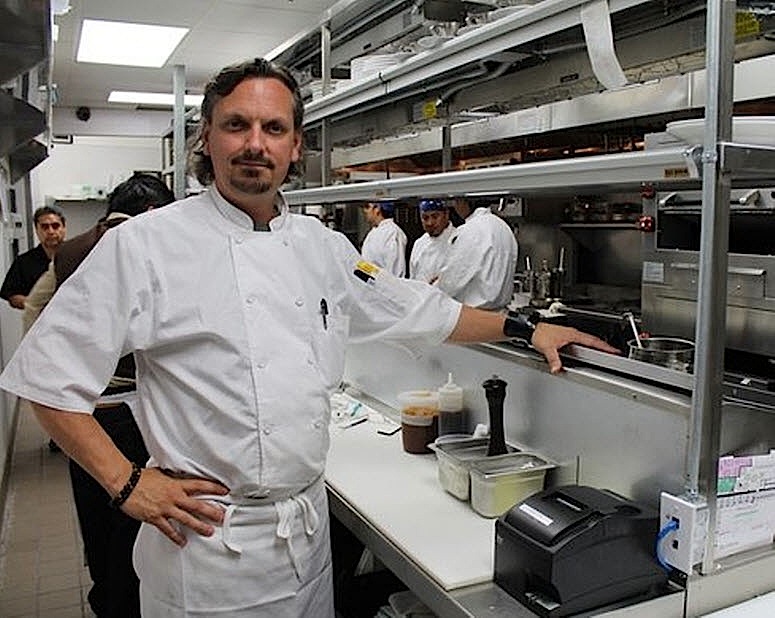 There are also private party rooms for 12
to 200 people, and the restaurant is closed Sundays and
Mondays for those parties alone. (The owners, S
Hospitality Group, also run Studio Square Beer Garden
and the adjacent event spaces.)
There are also private party rooms for 12
to 200 people, and the restaurant is closed Sundays and
Mondays for those parties alone. (The owners, S
Hospitality Group, also run Studio Square Beer Garden
and the adjacent event spaces.)
Executive Chef Joel
Reiss (left), a
Queens native and alum of first-rate NYC steakhouses
like The Post House and Smith & Wollensky, is as
serious about his ingredients as any chef I've ever met.
Everything is prepared on premises, including the dry
aging of Prime beef for 25, 35, and up to 60 days, which
is a ribeye that has justifiably become S Prime's
signature item (above).
The careful control gives the meat an earthiness that
will remind those who remember what beef used to taste
like 25 years in NYC steakhouses, with a fine, mottled
texture, true charring, and intensity of flavor.
The menu has a classic steakhouse
cast, but among all those dishes on comes to crave in
such a place, just about every one at S Prime stands out
from a very competitive crowd. Only a handful of
steakhouses in America show the consistency in every
dish that this one does, and you can tell it takes a
whole lot of work to achieve.
You might
start off with a bouquet of shellfish on ice, but not,
thankfully, too cold. The crab cakes are fat and
full of lump meat, graced with a lemon aïoli.
Bone marrow is lavished on brioche toast (made here, of
course) with "ugly" ripe tomatoes and onion mustard
vinaigrette. 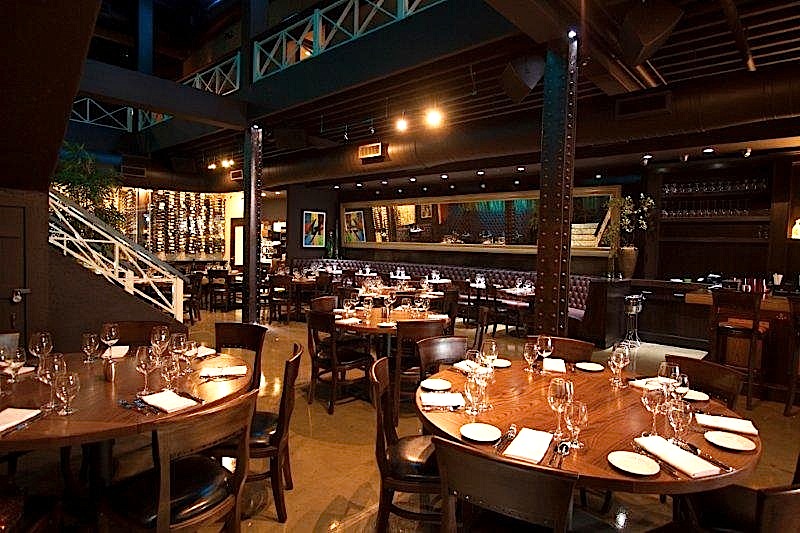 Foie gras--a good slice of
it--is accompanied by apple-quince puree with a verjus and
grapefruit reduction that shows you Reiss is going a
step ahead of his competition. White water mussels are
steamed open in white wine and garlic, and the
tartares--there are three, beef, spicy tuna, salmon with
yogurt and "everything" bagel chip, and they can all be
had on one generous plate. The pork belly is a sizzling
slab of bacon-like meat.
Foie gras--a good slice of
it--is accompanied by apple-quince puree with a verjus and
grapefruit reduction that shows you Reiss is going a
step ahead of his competition. White water mussels are
steamed open in white wine and garlic, and the
tartares--there are three, beef, spicy tuna, salmon with
yogurt and "everything" bagel chip, and they can all be
had on one generous plate. The pork belly is a sizzling
slab of bacon-like meat.
In a steakhouse, one of the ways to
judge it across the board is how they do lobster, and
the big three-pounder I ordered was superb, the claws
chockful of meat. From the meat locker you can order any
of those steaks above or go with a spicy Cajun ribeye or
Colorado rack of lamb. One dish that is impressive
as much for its size as its taste is the Veal Chop
"Parmanese," an awkward name for a massive, 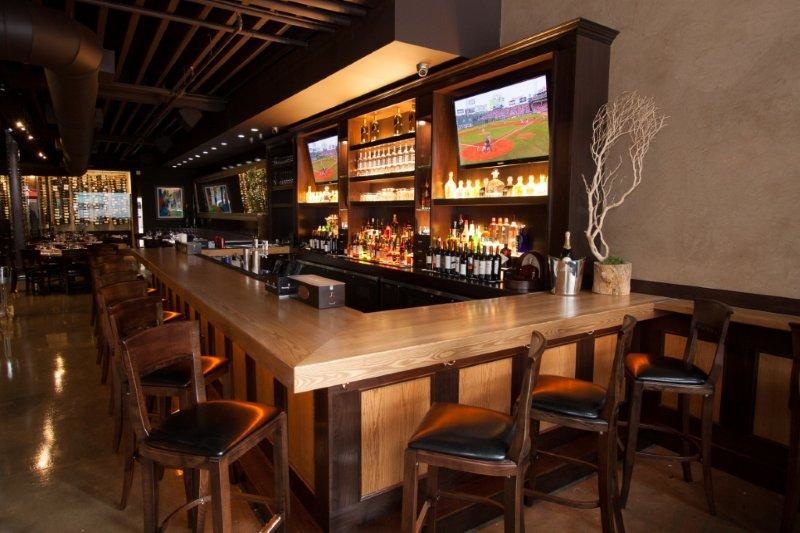 pounded veal chop with mozzarella and
tomato. We all took a piece of it and I still
brought some home. If you're in the mood for
seafood, have the buttery scallops with white bean and
bacon ragout.
pounded veal chop with mozzarella and
tomato. We all took a piece of it and I still
brought some home. If you're in the mood for
seafood, have the buttery scallops with white bean and
bacon ragout.
The sides
(called "good" and "bad," monikers they should get rid
of on the menu) include superlative creamed spinach,
sweet tiny Brussels sprouts, irresistible
Parmesan-herbed French fries, and garlic-laced mashed
potatoes.
Most steakhouses stick to a small
group of desserts that are too often brought in from
outside, but Reiss conceives of and makes all of S
Prime's, from the classic NY cheesecake to one of the
best Key lime pies with raspberry sauce I've ever
had--the Key lime juice makes an enormous difference.
S Prime is an indicator, in the
quickly gentrifying section of Queens called Long Island
City, can compete handily with anything in Brooklyn,
including the revered Peter Luger's, where the
porterhouse are nonpareil and everything else is
inconsequential, including service and wine list. S
Prime's wine list is excellent, as are the breads, the
potatoes, the pies, and most distinctly the service
staff. And it's a helluva lot easier to get to
than to get to most places in Brooklyn, unless you live
in that borough.
Open
Tues.-Sat. from 4 PM.; Appetizers and Sides,
$8 - $19; Main Courses, $25-$53.
❖❖❖
NOTES
FROM THE WINE CELLAR
UNDERSTANDING WINESPEAK
by John Mariani
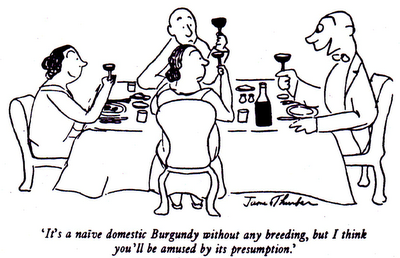
Every wine lover knows the famous
James Thurber cartoon in The New Yorker of a wine snob saying
to his dinner guests,“It’s a naïve domestic
burgundy, but I think you’ll be amused by its
presumption.” Or the parody of wine talk in Evelyn
Waugh’s “Brideshead Revisited” when two drunken heroes,
Charles and Sebastian (below),
describe various bottlings as “a little, shy wine like a
gazelle. . . . Like a leprechaun. . . . Dappled, in a
tapestry meadow” and “like the last unicorn.”
 As the business of
wine has become more serious, thereby demanding more
serious observations, the verbiage of less elegant
writers on wine is today more along the lines of what
sounds like a chemical breakdown: “Bret in the nose,
incomplete malolactic fermentation, a slight taste of
graphite, a scent of botrytis, and enough vanillin to
suggest overuse of new French barriques.”
As the business of
wine has become more serious, thereby demanding more
serious observations, the verbiage of less elegant
writers on wine is today more along the lines of what
sounds like a chemical breakdown: “Bret in the nose,
incomplete malolactic fermentation, a slight taste of
graphite, a scent of botrytis, and enough vanillin to
suggest overuse of new French barriques.”
If
you
love wine but haven't the foggiest notion of what any of
that means, you are probably not a true wine geek if you
are less interested in the science of viniculture than
what a wine actually tastes like. Of course, anyone can
simply make up blather to describe the taste of wine as
“cinnamon, Meyer lemon, papaya, Monte Cristo No. 2 with
Dominican wrapping, cat’s pee, and a hint of Sicilian
blood orange.” But
there are a few Winespeak terms you might want to become
familiar with for the next time a wine snob tries to
lord it over you.
Legs—Also,
“wine tears.” The ring of wine near the top of the glass
whose liquid creates tear-like droplets caused by a high
alcohol content. Or, more colloquially, those same
droplets caused by a thick, sweet wine.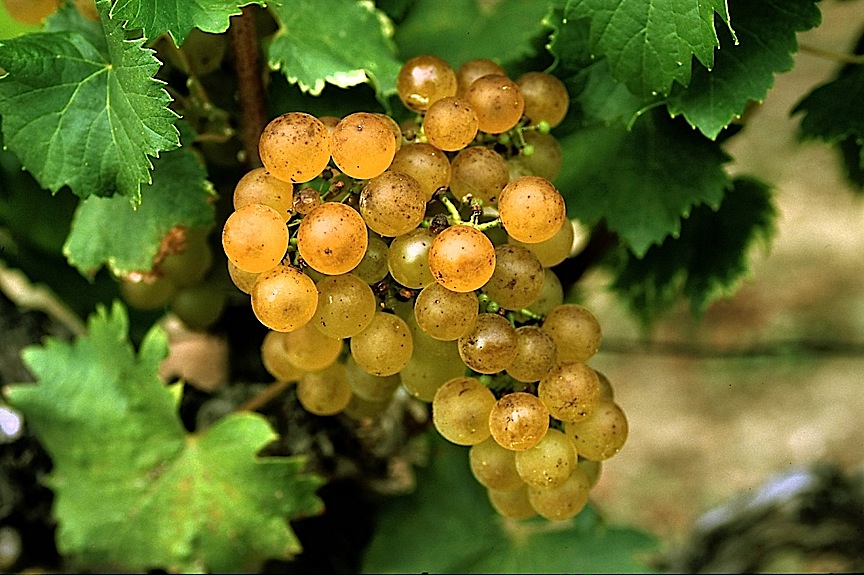
Grip—A vague term
suggesting that a sip of wine lingers on the palate
rather than just slip away.
botrytis cinerea (right)—A fungus on
grapeskins that rots the grapes but concentrates the
sugars and acids to make a very sweet but balanced wine
like French Sauternes or German trockenbeerenlause. In
grateful homage to this fungus, it is called the “Noble
Rot.”
brettanomyces—Or,
simply, “bret.” A chemical term for an unwanted yeast whose
volatile compounds can cause wines to have a barnyard or
wet blanket smell. Bret can live on many surfaces within
a winery and is treated with sulfur dioxide.
Brix—A
scale used to determine the must weight or sugar content
in grapes, determined by the numbers of sugar grams or
per 100 grams of water or as the percentage of content.
The number can provide winemakers of what the eventual
alcohol may be in the finished wine. One degree Brix
equals 18 grams per liter of sugar.
malolactic fermentation—After
a wine goes through its initial fermentation, a second
malolactic fermentation converts malic acid into lactic
acid via the Lactobacillus bacteria, releasing carbon
dioxide, which helps round out young wines. If the
second fermentation occurs in the bottle, the wine can
taste fizzy and taste unpleasant.
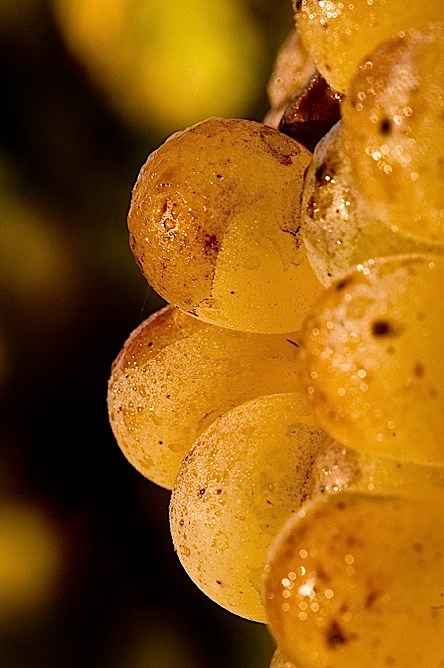 Phylloxera (left)—A tiny aphid
that can devastate vineyards by attacking grape vine
roots. From the 1860s on, the bug killed off 6.2 million
acres of vineyards in France alone, and was believed to
come from the U.S. on other imported plants. Europe’s wine
industry was only saved after graftings of resistant
American vines were made in the vineyards. An
infestation also hit California vineyards in the 1980s.
Phylloxera (left)—A tiny aphid
that can devastate vineyards by attacking grape vine
roots. From the 1860s on, the bug killed off 6.2 million
acres of vineyards in France alone, and was believed to
come from the U.S. on other imported plants. Europe’s wine
industry was only saved after graftings of resistant
American vines were made in the vineyards. An
infestation also hit California vineyards in the 1980s.
biodynamic
wines—When the term refers to wines made
according to techniques that emphasize the healthiest,
organic vineyard practices with no use of chemical
fertilizers, it is a process focused on the soil. The term
becomes controversial when some winemakers factor in the
effects of the moon cycle wherein plantings, spraying,
and organic fertilization is done according to the signs
of zodiac.
chaptalization—The addition of sugar to wine must intending to boost the alcohol level, named after French agronomist Jean-Antoine Chaptal, who published his findings in 1799. In some wine regions the practice is forbidden, but it is widely used in vineyards, including Burgundy, where the sun may not create enough sugar in the grapes.
❖❖❖
 BOTTOMS
UP!
BOTTOMS
UP! In
Gijón, Spain, an assistant chef at the
cider house El Lavaderu
was arrested for 14 counts of poisoning his coworkers
by allegedly
introducing calcium cyanamide into the
employees' staff
meals for over a year.

On NYC Bice restaurant is serving a
with lobster and black truffles, served on a gold-leaf
platter
designed by late Gianni Versace.
Any of John Mariani's
books below may be ordered from amazon.com.
 |
My latest book, which just won the prize for best book from International Gourmand, written with Jim Heimann and Steven Heller, Menu Design in America, 1850-1985 (Taschen Books), has just appeared, with nearly 1,000 beautiful, historic, hilarious, sometimes shocking menus dating back to before the Civil War and going through the Gilded Age, the Jazz Age, the Depression, the nightclub era of the 1930s and 1940s, the Space Age era, and the age when menus were a form of advertising in innovative explosions of color and modern design. The book is a chronicle of changing tastes and mores and says as much about America as about its food and drink.
“Luxuriating vicariously in the pleasures of this book. . . you can’t help but become hungry. . .for the food of course, but also for something more: the bygone days of our country’s splendidly rich and complex past. Epicureans of both good food and artful design will do well to make it their coffee table’s main course.”—Chip Kidd, Wall Street Journal.
“[The menus] reflect the amazing craftsmanship that many restaurants applied to their bills of fare, and suggest that today’s restaurateurs could learn a lot from their predecessors.”—Rebecca Marx, The Village Voice. |
"Eating Italian will never be the same after reading John Mariani's entertaining and savory gastronomical history of the cuisine of Italy and how it won over appetites worldwide. . . . This book is such a tasteful narrative that it will literally make you hungry for Italian food and arouse your appetite for gastronomical history."--Don Oldenburg, USA Today. "Italian
restaurants--some good, some glitzy--far
outnumber their French rivals. Many of
these establishments are zestfully described
in How Italian Food Conquered the World, an
entertaining and fact-filled chronicle by
food-and-wine correspondent John F.
Mariani."--Aram Bakshian Jr., Wall Street
Journal.
"Equal parts
history, sociology, gastronomy, and just
plain fun, How Italian Food Conquered the
World tells the captivating and delicious
story of the (let's face it) everybody's
favorite cuisine with clarity, verve and
more than one surprise."--Colman Andrews,
editorial director of The Daily
Meal.com. "A fantastic and fascinating
read, covering everything from the influence
of Venice's spice trade to the impact of
Italian immigrants in America and the
evolution of alta cucina. This book will
serve as a terrific resource to anyone
interested in the real story of Italian
food."--Mary Ann Esposito, host of PBS-TV's
Ciao
Italia. "John Mariani has written the
definitive history of how Italians won their
way into our hearts, minds, and
stomachs. It's a story of pleasure over
pomp and taste over technique."--Danny Meyer,
owner of NYC restaurants Union Square Cafe,
Gotham Bar & Grill, The Modern, and
Maialino.
|
 |
 |
 |
 |
 |
 |
 |
 |
 Everett Potter's Travel Report:
Everett Potter's Travel Report: 
 Eating Las Vegas
is the new on-line site for Virtual Gourmet
contributor John A. Curtas., who since 1995
has been commenting on the Las Vegas food
scene and reviewing restaurants for Nevada
Public Radio. He is also the
restaurant critic for KLAS TV, Channel 8 in
Las Vegas, and his past reviews can be
accessed at KNPR.org.
Click on the logo below to go directly to
his site.
Eating Las Vegas
is the new on-line site for Virtual Gourmet
contributor John A. Curtas., who since 1995
has been commenting on the Las Vegas food
scene and reviewing restaurants for Nevada
Public Radio. He is also the
restaurant critic for KLAS TV, Channel 8 in
Las Vegas, and his past reviews can be
accessed at KNPR.org.
Click on the logo below to go directly to
his site.

Tennis Resorts Online: A Critical Guide to the World's Best Tennis Resorts and Tennis Camps, published by ROGER COX, who has spent more than two decades writing about tennis travel, including a 17-year stretch for Tennis magazine. He has also written for Arthur Frommer's Budget Travel, New York Magazine, Travel & Leisure, Esquire, Money, USTA Magazine, Men's Journal, and The Robb Report. He has authored two books-The World's Best Tennis Vacations (Stephen Greene Press/Viking Penguin, 1990) and The Best Places to Stay in the Rockies (Houghton Mifflin, 1992 & 1994), and the Melbourne (Australia) chapter to the Wall Street Journal Business Guide to Cities of the Pacific Rim (Fodor's Travel Guides, 1991).


MARIANI'S VIRTUAL GOURMET
NEWSLETTER is published weekly. Editor/Publisher: John
Mariani.
Contributing Writers: Christopher Mariani, Robert Mariani,
John A. Curtas, Edward Brivio, Mort Hochstein,
Suzanne Wright, and Brian Freedman. Contributing
Photographers: Galina Stepanoff-Dargery,
Bobby Pirillo. Technical Advisor: Gerry McLoughlin.
© copyright John Mariani 2013
